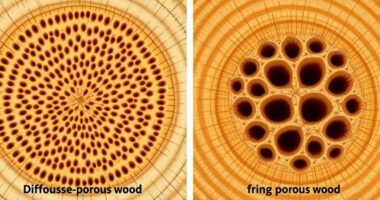To predict wood movement, examine each growth ring’s width—wide rings mean faster growth and less shrinkage, while narrow rings indicate slower growth and more potential for movement. Observe the contrast between earlywood and latewood, noting variations that reflect environmental conditions. Consistent wide or narrow rings suggest steady or stressed growth, respectively. By understanding these patterns, you can anticipate how the wood might respond to moisture changes—if you keep exploring, you’ll discover even more useful insights.
Key Takeaways
- Identify the width of each growth ring; wider rings indicate rapid growth, narrower rings suggest slower growth, affecting wood stability.
- Differentiate between earlywood and latewood within each ring to assess density and moisture content variations.
- Observe the pattern of ring widths over multiple years to detect environmental stress or favorable growth periods.
- Narrow, consistently spaced rings may signal increased risk of wood shrinkage and movement when dried.
- Use growth ring analysis to anticipate how wood will respond to moisture fluctuations, aiding in predicting swelling or shrinking.

Understanding how to read growth rings is vital for learning about a tree’s age and growth history. When you examine a cross-section of wood, you’ll notice a series of concentric rings, each representing a year of growth. These rings, called growth rings, are the key to understanding how a tree has developed over time. The width of each ring, or ring width, varies depending on environmental conditions such as rainfall, temperature, and overall health. By studying these variations, you can interpret the tree’s annual patterns, which reveal periods of rapid growth or slow development. Recognizing these patterns helps you predict how the wood will respond to environmental factors, including moisture and temperature fluctuations.
When you look closely at a growth ring, you’ll see that the ring itself is made up of two parts: the earlywood and the latewood. Earlywood forms at the beginning of the growing season and tends to be lighter, with larger cells that allow for quick water transport. Latewood appears as the season progresses and consists of smaller, denser cells, giving it a darker appearance. The contrast between these two parts creates the visible ring pattern. The width of each ring can tell you a lot about the environmental conditions during that year. For instance, a wide ring indicates favorable growing conditions, often associated with ample rainfall and ideal temperatures. Conversely, narrow rings suggest stressful conditions, such as drought or cold weather, which hinder growth.
Tracking the annual patterns of ring width over multiple years helps you understand how the tree has responded to changing environmental factors. Consistent wide rings suggest periods of steady, healthy growth, while fluctuating ring widths can indicate environmental variability or stress. This information is vital for predicting wood movement because wood tends to shrink and swell depending on moisture levels. Knowing the growth history gives you insight into how the wood might behave under different conditions, especially in woodworking or construction projects where stability is essential. Additionally, growth rings can sometimes reveal the impact of climate change on the tree’s development over time.
Frequently Asked Questions
How Does Climate Affect Growth Ring Formation?
Climate variation directly impacts growth ring formation by influencing annual climate conditions, moisture levels, and temperature fluctuations. When the climate is wet and warm, growth rings tend to be wider due to increased cell growth. Conversely, droughts or cold years produce narrower rings. You can observe these patterns to understand how annual climate changes affect wood development, helping you predict potential wood movement caused by environmental shifts over time.
Can Growth Rings Indicate Wood Quality?
You can often tell wood quality by examining growth rings, especially ring uniformity. Denser wood with tightly packed, consistent rings typically indicates higher quality and durability. Variations in ring size or irregularities may suggest lower density or stress during growth, affecting overall strength. By analyzing these features, you get insights into the wood’s density and structural integrity, helping you assess its suitability for specific projects or applications.
Do Different Wood Species Have Distinct Growth Ring Patterns?
You might think all wood species show similar growth ring patterns, but that’s not true. Different species variation results in distinct ring pattern differences, making each type unique. Recognizing these variations helps you identify the species and understand how it might react to environmental changes. So, by observing the ring patterns closely, you can predict how the wood will behave, especially when considering its movement and stability over time.
How Accurate Are Growth Rings in Predicting Wood Movement?
You might wonder about the accuracy of growth rings in predicting wood movement. Growth ring variability can make predictions tricky, but careful ring pattern interpretation helps. While growth rings provide clues about moisture content and potential shrinkage or swelling, other factors like species and environmental conditions also influence movement. So, while useful, growth rings alone aren’t perfectly reliable, and combining this method with other assessments gives better accuracy.
Can Growth Ring Analysis Be Done Without Specialized Tools?
Think of growth ring measurement like reading a map: you don’t need fancy tools, just keen eyes. You can perform visual analysis of growth rings to gauge wood movement, but it’s less precise without specialized tools. I once examined a piece of aged wood using only my eyes and a magnifying glass, which helped me spot patterns. While possible, for accuracy, consider investing in simple tools for better insights.
Conclusion
By learning to read growth rings, you can better predict how wood will move over time. Imagine a tree that adds about 1,000 growth rings in just 50 years—each ring telling a story of seasonal change and moisture levels. Understanding these rings helps you anticipate expansion or contraction in your woodworking projects, saving you time and frustration. With this knowledge, you’ll turn raw wood into beautifully stable pieces, grounded in nature’s own history.









